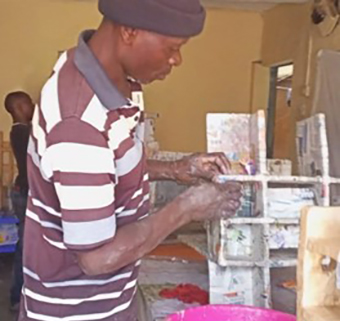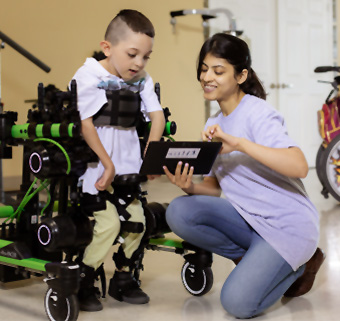Sarah, Me Happy!
| January 2011No one who visits Darvell could possibly miss Sarah. A shiny-eyed girl whose jet-black hair sticks out saucily from under her safety helmet, she breaks into a wide grin at the slightest sign of attention. Whether climbing a ladder to the top of a slide or fingering a flower in the yard, she’s all there, chattering a steady mix of Korean and English, brimming with energy, and chuckling with a throaty laugh that could disarm Scrooge.
It wasn’t always this way. When Sarah was born in 1997, her parents, Kevin and Jeanie, could not have been happier. Their first child, she turned their lives (and their sleeping schedules) upside down. Born in England just months after they had left their native Seoul, she also secured their ties to a new land. But if she first brought happiness, Sarah’s snail-paced development soon made her the object of growing concern, and then open anxiety. At one year, though strong and healthy looking, she moved little and rarely made noises. At eighteen months, she was unable to sit up, let alone walk. At four, she could still only crawl, and her speech was still limited to a half-dozen words. On the whole she was content to lie back in her stroller and watch the world go by.
First regarded as a “developmental delay,” Sarah’s disability defied diagnosis. (Her doctors now describe it as an “ataxic disorder”— a debilitating absence of muscle tone in her shoulders, hips and spine.) Kevin and Jeanie carried and hugged her, talked and sang to her. They loved her with all they had. But she made no signs of progress.
When Sarah was three, her family (including her new baby brother, Sejune) moved to Darvell. Rachel, a physical therapist, began to work with her on a daily basis. In Rachel's words:
 We began by trying to improve Sarah’s mobility. We used a gait trainer, but it was a long, hard road. She knew how to crawl, but she had never really used her legs to bear weight, or to propel herself while upright. It took six months of intensive therapy before she could move herself forward more than ten feet at a time. Then she took off. Once she clicked that she could get where she wanted on her own steam, she began to go places.
We began by trying to improve Sarah’s mobility. We used a gait trainer, but it was a long, hard road. She knew how to crawl, but she had never really used her legs to bear weight, or to propel herself while upright. It took six months of intensive therapy before she could move herself forward more than ten feet at a time. Then she took off. Once she clicked that she could get where she wanted on her own steam, she began to go places.
Recalling a conversation she had with Jeanie, Rachel says, “She wanted her daughter to learn to get from the bedroom to the bathroom, use the toilet, and get back again—by herself. I groaned. I thought it would be impossible.”
Two years later, Sarah has met that “impossible” goal, and many more. Indoors, she scoots around the house using her gait trainer, and has even begun to walk on her own, with the help of two canes. Outdoors, a tricycle gets her around as fast as any other kid. Swings, slides, merry-go-rounds, the sandbox—nothing is out of bounds anymore.
Sarah’s life has changed in other ways too. With Serin, a new little sister to help take care of at home, and a program that fully includes her in the activities of her peers, she is rarely by herself these days. To quote her kindergarten teacher:
Sarah’s always where the action is. She has no problems talking anymore, even though she’s a few years behind her age-group. She is always yelling hello at passersby, or organizing her friends in the block corner. She sings her heart out. And at Monday show-and-tell, she’s the first to volunteer information about the weekend…On top of all this, she’s starting school this fall. Her life couldn’t be fuller.
Not long ago, Sarah dictated a letter to a family friend now living in New York: “To Edith. Purple flower. Dance, play! Pebbles, moss—little garden. Walk—me walk… Me happy. Everyone in Darvell happy! See you soon…Goodbye to you. Enough! Sarah.
 “Enough” says it all. For what more does a child need when she is bursting with such joy? There are other, more mundane, necessities for living, of course. Sarah may depend on special equipment for the rest of her life. But that is only one part of the picture, one overshadowed by other, more important factors. The dreams of a mother with an “impossible” goal. The therapist who won’t give up. The teacher who encourages each pupil to blossom in her own unique way. When they all work together, they can awaken a listless body, and give a once-silent voice the confidence to sing. Together, they can uncover the happiness that lies hidden in every child’s heart.
“Enough” says it all. For what more does a child need when she is bursting with such joy? There are other, more mundane, necessities for living, of course. Sarah may depend on special equipment for the rest of her life. But that is only one part of the picture, one overshadowed by other, more important factors. The dreams of a mother with an “impossible” goal. The therapist who won’t give up. The teacher who encourages each pupil to blossom in her own unique way. When they all work together, they can awaken a listless body, and give a once-silent voice the confidence to sing. Together, they can uncover the happiness that lies hidden in every child’s heart.





